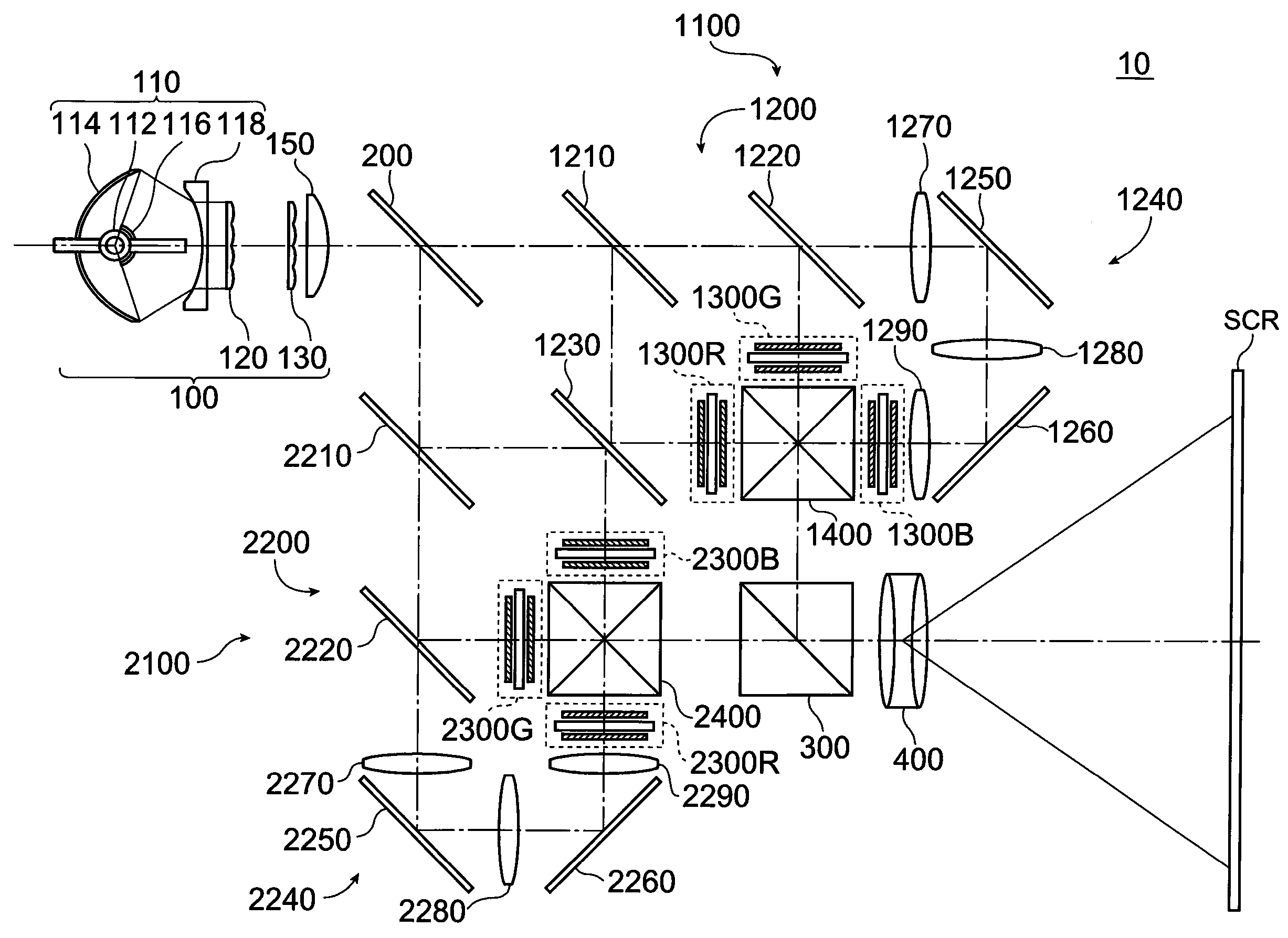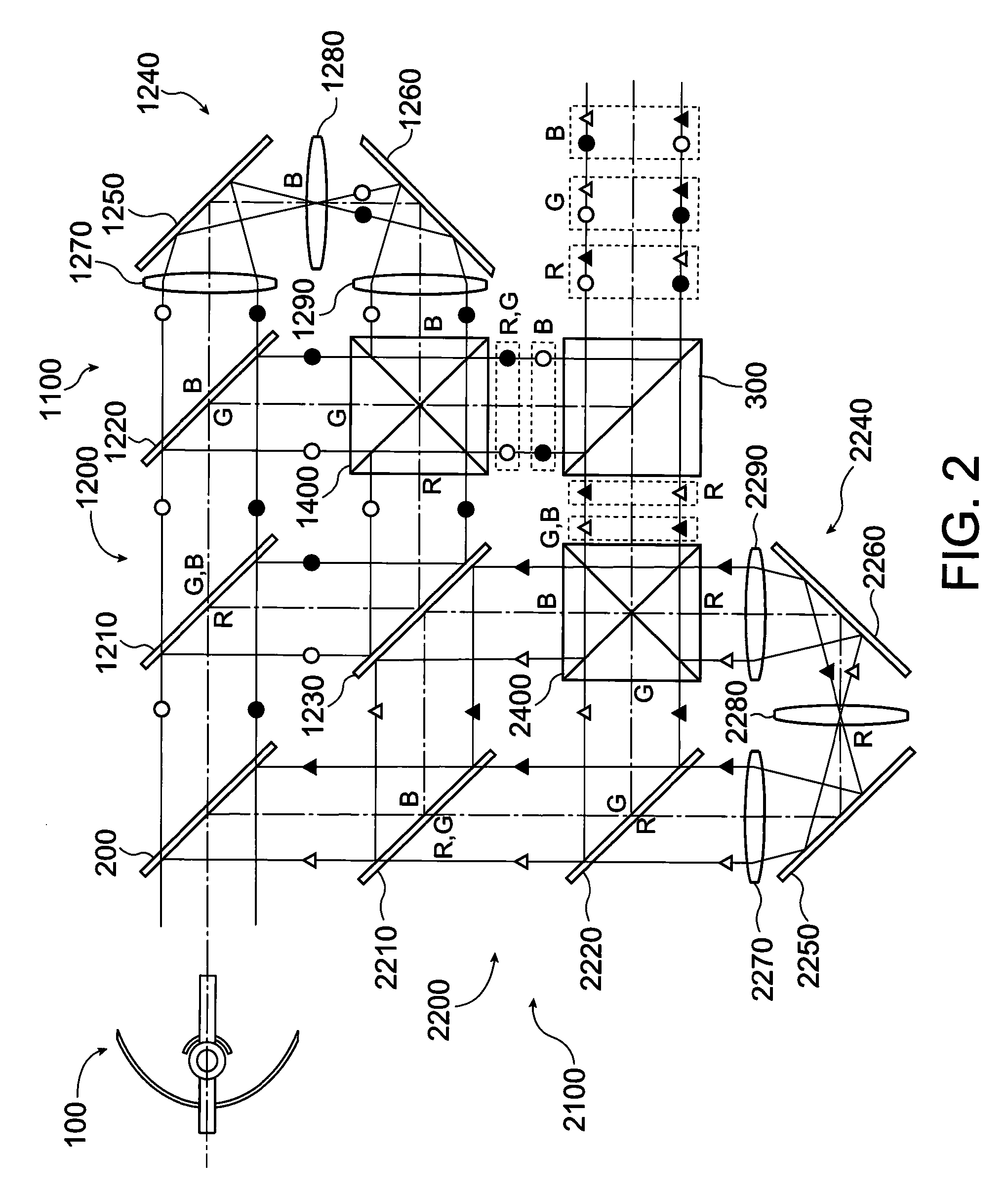Projector
a projector and projector technology, applied in the field of projectors, can solve the problems of affecting the image quality of the projected image, so as to prevent the generation of color shading and prevent the degradation of the projected image quality
- Summary
- Abstract
- Description
- Claims
- Application Information
AI Technical Summary
Benefits of technology
Problems solved by technology
Method used
Image
Examples
first embodiment
[0066]FIG. 1 diagrammatically shows the optical system of a projector 10 according to a first embodiment. The projector 10 according to the first embodiment includes, as shown in FIG. 1, an illuminator 100 that emits light containing red light (first color light), green light (second color light), and blue light (third color light), a polarization separation mirror 200 as a polarization separation system, a first image formation unit 1100 as first image formation means that outputs first image light, a second image formation unit 2100 as second image formation means that outputs second image light, a polarization combining prism 300 as a polarization combining system, and a projection system 400 that projects image light combined in the polarization combining prism 300.
[0067]The illuminator 100 includes a light source 110 that emits an illumination light flux toward the area to be illuminated, a concave lens 118 disposed on the side of the illuminator 110 that faces the area to be i...
second embodiment
[0111]In the projector 10 according to the first embodiment, the optical system is configured in such a way that for each of the red and blue light, the image light beams corresponding to the same color light beams outputted from the first and second image formation units 1100 and 2100 are reversed from each other in the right-left direction on the projection surface. Alternatively, by carrying out the reverse projection in the right-left direction on the screen SCR described above for the green and the blue light, instead of the red and blue light, an advantage of preventing unevenness in the amount of light in the image projected on the screen SCR is provided.
[0112]FIG. 3 diagrammatically shows the optical system of a projector 20 according to a second embodiment. As shown in FIG. 3, the projector 20 according to the second embodiment has a configuration similar to that shown in FIG. 1 except that the fourth dichroic mirror 2220 serves to reflect the red light and transmit the gre...
third embodiment
[0125]As in the projector 10 according to the first embodiment and the projector 20 according to the second embodiment, when the first image formation unit 1100 and the second image formation unit 2100 share the double-sided reflection mirror 1230, it is preferable to provide an optical axis adjuster for appropriately positioning the optical axes of the color light beams reflected off the reflection surfaces of the double-sided reflection mirror 1230 in the optical systems of the first image formation unit 1100 and the second image formation unit 2100. A projector 30 according to a third embodiment will be described with reference to the case where the optical axis adjuster is a lens for adjusting the optical axis of color light (hereinafter referred to as optical axis adjustment lens).
[0126]FIG. 5 diagrammatically shows the optical system of the projector 30 according to the third embodiment. While the optical system of the projector 30 according to the third embodiment has the sam...
PUM
 Login to View More
Login to View More Abstract
Description
Claims
Application Information
 Login to View More
Login to View More - R&D
- Intellectual Property
- Life Sciences
- Materials
- Tech Scout
- Unparalleled Data Quality
- Higher Quality Content
- 60% Fewer Hallucinations
Browse by: Latest US Patents, China's latest patents, Technical Efficacy Thesaurus, Application Domain, Technology Topic, Popular Technical Reports.
© 2025 PatSnap. All rights reserved.Legal|Privacy policy|Modern Slavery Act Transparency Statement|Sitemap|About US| Contact US: help@patsnap.com



